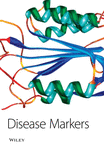DJ-1 Variants in Indian Parkinson’s Disease Patients
Abstract
Parkinson’s disease (PD) is a common neurodegenerative movement disorder. Among the candidate genes, DJ-1 accounts for about 1% of the cases in different populations. We aim to find the contribution of the gene towards PD among Indians. By screening DJ-1 in 308 PD patients of eastern India and 248 ethnically matched controls, a total of 21 nucleotide variants – including two nonsynonymous changes – were detected. p.Arg98Gln was identified in 6 unrelated patients and 2 controls while p.Val35Ile, a novel change, was found only in 2 unrelated patients. A SNP (rs7517357) was observed to be moderately associated with increased risk of PD (p < 0.05). The deletion allele (g.168–185del) of a known 18 bp del/ins/dup polymorphism was found to be over represented (p < 0.05) among older patients (> 40 years) compared to the controls (> 45 years). Two of the patients, also heterozygotes for PINK1 mutation, had more severe disease phenotypes, consistent with the reported interaction between PINK1 and DJ-1 gene products [19]. Our results demonstrate that up to 3.9% (12/308) of PD patients of eastern India harbor DJ-1 variants that should be explored further for any causal relationship with PD.




